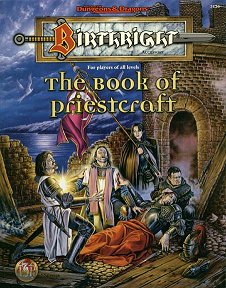
Never mind the Birthright setting, if you want to play a Priest character as more than a healing machine who casts spells (never mind that they're divine in origin rather than arcane) and can fight a bit, this is worth a look. If you are playing Birthright, all the better... let your Priest take a full part in the intrigue and manoeuvering that is part and parcel of this unique game.
It starts with a thorough review of the different gods in the pantheon of Cerilia. Your chosen deity need never again be merely a name on your character sheet... you will know all about him or her, understand the organisation of that deity's church and know the festivals and rituals, and if you are playing a priest or a paladin you know what you need to do and what powers you get. So even if you are merely a devout individual rather than one of the 'professionally' religious, the bits about the deity and the church are worth reading!
It's really all quite fascinating. There's enough here to fuel many a religious debate between devotees of different deities, you can learn about different orders and strands of belief even within the faith of a single deity... this really makes the clerical scene come to life, providing a rich backdrop to everyday life. Even the most worldly folk will find the odd festival worth celebrating, or may seek a church in times of need... or just when they want to get wed or have dead to bury.
You may think this is overkill, but it can add real depth and flavour to your game. When you find the ranger sneaking out at dawn to say his prayers or a paladin getting really embarassed because the murder he's investigating has led him to have to quiz the Madam of a brothel... then you know that your game's alternate reality is coming to life in your players' minds. Giving them this level of detail about the deity they casually wrote on their character sheet is a part of it.
The next chapter is Strategies and Tactics, and it is particularly aimed at those players who decide that their Regent character is a priest by trade, although much of what is said can work equally well for the clerical cohorts of a Regent who is a layman. A Priest-Regent has great assets at his command, but is also quite a good target! Any senior clergyman will have cohorts and most wield some temporal power as well as spiritual power - owning lands and commanding allegiances, for example. Diplomacy, the role of faith in peace and in war, even the relationships between faith and state are discussed here. Even a layman Regent is likely to have some religious beliefs, and these can have a significant effect on the support he receives and on which faith is regarded as the 'state religion' in his domains.
And then there's ceremonial as a political tool. Most Regents want some kind of investiture or coronation ritual to mark their assumption of office, and such ceremonies are generally religious in nature. This has special significance if people believe in a sacred bond between a ruler and his domain... one which can be established by spell and ritual.
The final part of the book covers spell lists (and plenty new spells) for priests of the different Cerilian faiths, battle magic, spells for Regents and an array of magical items and relics.
Even a cursory study of history will show you how in the real world religion and politics and statecraft are entwined: with this book you are equipped to generate the same level of involvement and intrigue within the context of a Birthright game... or give you ideas for how to do so even if it's not Birthright that you are playing!
Return to The Book of Priestcraft page.
Reviewed: 5 August 2014

